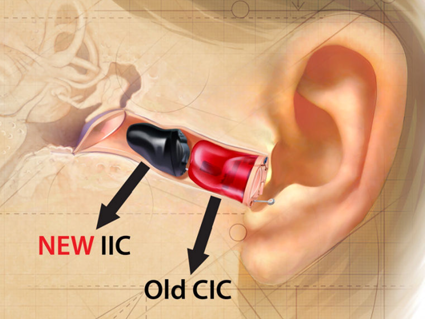#2. How Hearing-Impaired Improve What We Can Hear

A few days ago I ran into an info on a famous hearing aid manufacturer Phonak’s web site.
According to their (I am sure, too optimistic) estimate, their newest type of hearing aids- IIC (Invisible-In-Channel) - can fit no more than 50% of potential users due to the variations in individual ear channel anatomy.
It’s interesting to note that despite this limitation the hearing aid industry invested millions and millions of dollars to provide this solution.
The reason: deep insertion, obviously, is the only way to achieve invisibility - the hearing aid’s Holy Grail.
Contrary to this position Consumer Electronics companies would never admit, and, probably, never do anything that would, in their opinion, even slightly limit their, allegedly, universal appeal on the market.
Then a question arises: how many technological breakthroughs in CE never materialize due to this strive for commonality?
The loss is especially annoying as with the claims for universal appeal, distorting public opinion, the CE manufacturers still very rarely deliver it. In the case of portable audio, this distortion means that in the vast majority of purchasing decisions a quick auditioning, with no awareness of principle "no pain, no gain" (as, in hearing aids application), decides.
The same Phonak site source states that customer adjustment time for an IIC can take up to two weeks of 24/7 constant use. After that a decision is taken with a help of an audiologist. It is a result of a decision baseline consisting of both a determination for some reasonable ongoing effort on customer's side, and an ability to see all the necessary compromises involved.
But the most important aspect in taking the final decision and making the final choice of an appropriate hearing aid is a set of some clearcut priorities in mind of the customer.
My own experience with ear channel second bend IEMs brought an interesting insight: the more you wear them, the better they sound. And it’s not only due to the infamous audiophile burn-in phenomena. The reason is two-fold: first, your inner psychology adjusts to a "new organ of your body" and stops the corresponding "ring" in your brain, and, second, the ear channel cartilage issue with constant usage, due to its texture, anatomically adapts with a better seal of your ear channel. Additionally, new hearing and listening habits are formed, the same way as they gradually form from ground level up in a case of home audiophiles who just started their pursuit of audio.
It can take much longer than two weeks, but the comfort and sonic rewards are more than worth the ongoing effort.
Even if in earphone technologies deep insertion serves a different priority than in hearing aids, reaching portable audio's Holy Grail is, likewise, impossible without it. For many similar reasons, but the main one is that the acoustic transducers - I repeat, transducers, not the custom molds material with the sound bores - should be placed sufficiently deep at the ear channel, at or in vicinity of the second bend of an ear channel, where the “old” CIC aids are being often successfully positioned by audiologists. It's, obviously, for a reason, that all latest developments in hearing aid applications were taking the devices deeper and deeper inside the ear channel.
There is no doubt that IEMs deeper "IIC" positioning, via possible future developments, can advance their sound quality even further.
The good quality deep insertion serves the same purpose sonically as the proper loudspeaker placement in the room, where such a placement puts an audiophile in the nearfield listening position. Correspondently, sufficiently deep In-the-Ear Monitor (IEM) insertion allows you to elevate a portable audio playback quality to such a high level that it'll be very similar in its sonic aspects to what you can get from an excellent and properly installed home High End Audio system.
Should the portable audio enthusiasts be aware of these two adjucent industries' design approach difference? I think they should, because being aware of this will help them to be able to consciously stay on the right course in their attempts to reach for the sonic Nirvana.
Also they should be fully aware of this because they should be determined to spend the necessary effort and to be better prepared for gains and trade offs in front of them.
And last, but not least, they also must be aware of this difference because they have to pray relentlessly to God in the hope that the size of their ear channels will pass the admission test, and as a result of it they would end up within that 50% of the lucky ones.
16.12.2015 // Author: (Bigmisha) // Number of views: 2083
